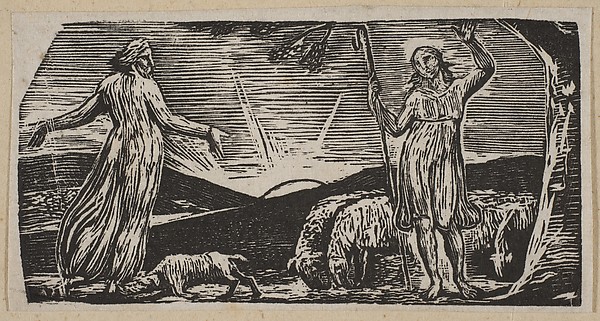 |
| Metropolitan Museum of Art Illustrations to Pastorals of Virgil
Thenot Remonstrates With Colinet
|
"The impact of these exquisite designs is best expressed in the words of Samuel Palmer: 'I sat down with Mr. Blake's Thornton's Virgil woodcuts before me, thinking to give their merits my feeble testimony. I happened to think first of their sentiment. They are visions of little dells, and nooks, and corners of Paradise; models of the exquisitest pitch of intense poetry. I thought of their light and shade, and looking upon them found no word to describe them. Intense depth, solemnity, and vivid brilliancy only coldly and partially describe it. There is in all such a mystic and dreamy glimmer as penetrates and kindles the innermost soul, and gives complete and unreserved delight, unlike the gaudy daylight of this world. They are like all that wonderful artist's works the drawing aside of the earthly curtain, and the glimpse which all the most holy, studious saints and sages have enjoyed, that rest which remaineth to the people of God.' The designs had an over-whelming impact on Palmer's visionary works of the Shoreham period and also on the engravings of Edward Calvert." Page 138
It seems to have been impossible for Blake to be half-hearted about any project in which he engaged or to please any who were not inclined to respect his visionary art. When John Linnell arranged for Blake to produce some illustrations for Dr Thornton's reprint of his Pastorals of Virgil, Blake learned the technique to woodcutting instead of using his usual engraving technique. We can follow the production process from the original watercolor sketches, through at least one conventional engraving, to the blocks of the woodcuttings, to the proof sheets, and to the prints in the book. Thornton was not satisfied with the original woodcuts but became reconciled to using them when he learned how highly they were respected by other artists. Thornton introduced Blake illustrations with faint praise.
The curator of the British Museum writes:
"Introducing Blake's illustrations to Philips's eclogue Thornton writes that they 'display less of art than genius', although he also boasts that they are by 'the famous Blake'. Certainly, Blake's wood engravings were extremely unconventional: they were also clearly more artistically ambitious than the numerous other illustrations in 'Pastorals of Virgil'".
Dr Thornton would have done well to read from Blake's Descriptive Catalogue to learn that the visionary artist is representing realities unseen by the 'mortal perishing organ of sight' which sees only 'a cloudy vapour or a nothing'. To the artist the imagination is the visionary eye through which spiritual existence is made known. The image he produces conveys the lineaments of the object represented, not the superficial appearance. Unless the viewer sees through his imagination to the underlying spirit which is animated, the picture is nothing but a misrepresentation of nature.
Descriptive Catalogue , (E 541)
"The connoisseurs and artists who have made objections to
Mr. B.'s mode of representing spirits with real bodies, would do
well to consider that the Venus, the Minerva, the Jupiter, the
Apollo, which they admire in Greek statues, are all of them
representations of spiritual existences of God's immortal, to
the mortal perishing organ of sight; and yet they are embodied
and organized in solid marble. Mr. B. requires the same latitude
and all is well. The Prophets describe what they saw in Vision
as real and existing men whom they saw with their imaginative and
immortal organs; the Apostles the same; the clearer the organ the
more distinct the object. A Spirit and a Vision are not, as the
modern philosophy supposes, a cloudy vapour or a
nothing: they are organized and minutely articulated beyond all
that the mortal and perishing nature can produce. He who does
not imagine in stronger and better lineaments, and in stronger
and better light than his perishing mortal eye can see does not
imagine at all. The painter of this work asserts that all his
imaginations appear to him infinitely more perfect and more
minutely organized than any thing seen by his
mortal eye. Spirits are organized men: Moderns wish to
draw figures without lines, and with great and heavy shadows;
are not shadows more unmeaning than lines, and more heavy? O
who can doubt this!"
.

No comments:
Post a Comment